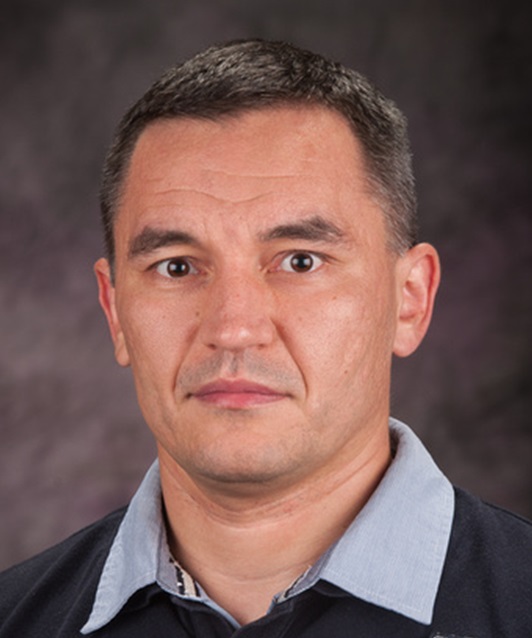A novel task and data regrouping based parallel approach to solve massive problems faster on multithreaded computing systems
Abu Asaduzzaman, Assistant Professor of Electrical Engineering & Computer Science, Wichita State University
The growing demand for developing energy-efficient faster computing systems is fueling the interest in developing better concurrent/parallel techniques to solve computation intensive problems. In designing methods for parallel computing, both the extent of the difficulty and the nature of the proposed solutions depend significantly on programming and architectural constraints. Current state of the knowledge on parallel processing is focused on designing massively multithreaded systems. The aim of this research is to develop an innovative task and data regrouping based parallel strategy to solve complex problems faster for saving energy and time and thus minimizing environmental and climate impacts.
Coherent transport and localization dynamics of excitons in molecular aggregates
Wai-Lun Chan, Assistant Professor of Physics and Astronomy, University of Kansas
One of the major challenges in nano-structure based solar cells is to effectively direct photo-excited excitons to interfaces for charge dissociation. Nature provides a valuable lesson - effective exciton transport in photosynthetic complex is mediated by interplay between coherent coupling and incoherent trapping at reaction sites. Similar mechanisms should presence in organic materials but are neither well understood, nor utilized in photovoltaics applications. Using time-resolved photoemission spectroscopy and fluorescent spectroscopy, we will temporally, spatially, and energetically resolve the exciton dynamics in molecular aggregates. The results will be used to study the competition between ultrafast coherent transport and exciton localization.
Two-Dimensional Heterojunction Tunneling Transistors for Low Power Applications
Hsin-Ying Chiu, Assistant Professor of Physics and Astronomy, University of Kansas
The proposed research addresses the grand challenge of developing low power circuit design based on heterojunction tunneling transistors by artificially stacking atomically thin layers of nanomaterials, i.e. carbon-‐based nanomaterials and transition metal dichalcogenides (TMDs). Moreover, the proposed research will be conducted with a unique platform of combined electrical transport and optical pump-probe measurements, which can serve a broad range of research schemes of studying physics at interfaces between two different nanomaterials. Therefore, this research will utilize the unique heterojunction properties of novel nanomaterials to develop low power and high-performance nanodevice applications.
Development of an FPGA-based Adaptable Peak Current-mode Control
Erik Mayer, Assistant Professor of Electronics Engineering, Pittsburg State University
This research focuses on the development of an adaptable, peak current-mode control for use in buck and related power converters. The control will use the modified z-transform model to determine the optimal amount of compensating ramp necessary for converters operating under a wide range of conditions. The applications would include a converter for charging batteries with solar power and a buck converter replacement for pre-charge resistors in electric and hybrid vehicle inverters. The control will be FPGA-based which will allow for several concurrent controls to be implemented on a single integrated circuit along with supervisory control.
Computational Studies of Biocatalyst Systems for Biomass Conversion
Katie Mitchell-Koch, Assistant Professor of Chemistry, Wichita State University
Biorefining of cellulosic feedstock for the production of ethanol and other biofuels is a promising direction for energy independence and efficiency. Bioengineered enzymes are being developed by companies, such as Abengoa Bioenergy, for these purposes. Computational studies of enzyme-solvent and enzyme-substrate interactions will inform the rational design and engineering of enzymes. Results can be used to tailor the properties of these biocatalysts and their solvent systems in order to facilitate rapid transport of substrates to and from the active site, faster reaction rates, and catalyst specificity.
Multifunctional Copolymeric Photovoltaics
Shenqiang Ren, Assistant Professor of Chemistry, University of Kansas
This proposal will address a key challenge of multifunctional excitonic system: programming optical, electronic and magnetic properties by organic photovoltaic material design. The goal is to understand principles that govern rational design, synthesis and self-assembly of excitonic photovoltaic polymers, and to discover their unique coupling among room temperature excitonic multiferroic and photovoltaic properties. The project will be comprised of following interrelated sub-programs: (1) synthesis of semiconducting polymers with new optical, magnetic and electronic properties. (2) understanding of the integration between exciton multiferroics and photovoltaics to contribute the extension of exciton-based nanotechnology.
Charge and energy transfer upon inner-shell photoionization
Artem Rudenko, Assistant Professor of Physics, Kansas State University
Charge and energy transfer reactions drive numerous important processes in physics, chemistry and biology, with applications ranging from artificial photosynthesis to molecular electronics. This project aims at revealing basic mechanisms and time scales of charge rearrangement and energy redistribution in molecular systems upon inner-shell photoionization. After creating a localized source of positive charge by the core-shell absorption of an X-ray photon, charge and energy flow in different molecular environments will be studied on the atomistic level by coincident momentum spectroscopy. Expected results will shed light on fundamental interatomic relaxation processes and advance our understanding of radiation damage mechanisms.
To learn about past KNE First Awardees please visit
http://www.nsfepscor.ku.edu/first-awards-yr3.html







No comments:
Post a Comment
Note: Only a member of this blog may post a comment.